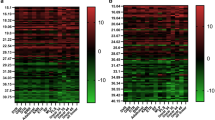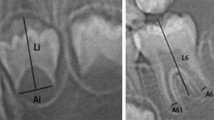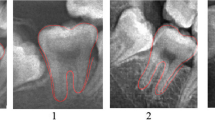Abstract
Context
Dental age, one of the indicators of biological age, is inferred by radiological methods. Two of the most commonly used methods are using Demirjian’s radiographic stages of permanent teeth excluding the third molar (Demirjian’s and Willems’ method). The major drawbacks of these methods are that they are based on population-specific conversion tables and may tend to over- or underestimate dental age in other populations. Machine learning (ML) methods make it possible to create complex data schemas more simply while keeping the same annotation system. The objectives of this study are to compare (1) the capacity of ten machine learning algorithms to predict dental age in children using the seven left permanent mandibular teeth compared to reference methods and (2) the capacity of ten machine learning algorithms to predict dental age from childhood to young adulthood using the seven left permanent mandibular teeth and the four third molars.
Methods
Using a large radiological database of 3605 orthopantomograms (1734 females and 1871 males) of healthy French patients aged between 2 and 24 years, seven left permanent mandibular teeth and the 4 third molars were assessed using Demirjian’s stages. Dental age estimation was then performed using Demirjian’s reference method and various ML regression methods. Two analyses were performed: with the 7 left mandibular teeth without third molars for the under 16 age group and with the third molars for the entire study population. The different methods were compared using mean error, mean absolute error, root mean square error as metrics, and the Bland-Altman graph.
Results
All ML methods had a mean absolute error (MAE) under 0.811 years. With Demirjian’s and Willems’ methods, the MAE was 1.107 and 0.927 years, respectively. Except for the Bayesian ridge regression that gives poorer accuracy, there was no statistical difference between all ML tested.
Conclusion
Compared to the two reference methods, all the ML methods based on the maturation stages defined by Demirjian were more accurate in estimating dental age. These results support the use of ML algorithms instead of using standard population tables.



Similar content being viewed by others
Data availability
The datasets generated during and/or analyzed during the current study are available from the corresponding author on reasonable request.
References
Moorrees CFA, Fanning EA, Hunt EE (1963) Age variation of formation stages for ten permanent teeth. J Dent Res 42:1490–1502. https://doi.org/10.1177/00220345630420062701
Jylhävä J, Pedersen NL, Hägg S (2017) Biological age predictors. EBioMedicine 21:29–36. https://doi.org/10.1016/j.ebiom.2017.03.046
Braga J, Heuze Y, Chabadel O, Sonan NK, Gueramy A (2005) Non-adult dental age assessment: correspondence analysis and linear regression versus Bayesian predictions. Int J Legal Med 119:260–274. https://doi.org/10.1007/s00414-004-0494-8
Cunha E, Baccino E, Martrille L, Ramsthaler F, Prieto J, Schuliar Y, Lynnerup N, Cattaneo C (2009) The problem of aging human remains and living individuals: a review. Forensic Sci Int 193:1–13. https://doi.org/10.1016/j.forsciint.2009.09.008
Willems G (2001) A review of the most commonly used dental age estimation techniques. Journal of Forensic Odonto-Stomatology 19:9–17
Sironi E, Gallidabino M, Weyermann C et al (2018) Bayesian networks of age estimation and classification based on dental evidence: a study on the third molar mineralization. J Forensic Legal Med 55:23–32. https://doi.org/10.1016/j.jflm.2018.02.005
Timme M, Steinacker JM, Schmeling A (2017) Age estimation in competitive sports. Int J Legal Med 131:225–233. https://doi.org/10.1007/s00414-016-1456-7
Galić I, Vodanović M, Cameriere R, Nakaš E, Galić E, Selimović E, Brkić H (2011) Accuracy of Cameriere, Haavikko, and Willems radiographic methods on age estimation on Bosnian-Herzegovian children age groups 6-13. Int J Legal Med 125:315–321. https://doi.org/10.1007/s00414-010-0515-8
Schmeling A, Geserick G, Reisinger W, Olze A (2007) Age estimation. Forensic Sci Int 65:178–181. https://doi.org/10.1016/j.forsciint.2006.05.016
Esan TA, Yengopal V, Schepartz LA (2017) The Demirjian versus the Willems method for dental age estimation in different populations: a meta-analysis of published studies. PLoS One 12:1–23. https://doi.org/10.1371/journal.pone.0186682
Demirjian A, Goldstein H, Tanner JM (1973) A new system of dental age assessment. Hum Biol 45:211–227
Thevissen PW, Fieuws S, Willems G (2011) Third molar development: measurements versus scores as age predictor. Arch Oral Biol 56:1035–1040. https://doi.org/10.1016/j.archoralbio.2011.04.008
Liversidge HM (2012) The assessment and interpretation of Demirjian, Goldstein and Tanner’s dental maturity. Ann Hum Biol 39:412–431
Lucas VS, Andiappan M, McDonald F, Roberts G (2016) Dental age estimation: a test of the reliability of correctly identifying a subject over 18 years of age using the gold standard of chronological age as the comparator. J Forensic Sci 61(5):1238–1243. https://doi.org/10.1111/1556-4029.13132
Jayaraman J, Roberts GJ, Wong HM, King NM (2018) Dental age estimation in southern Chinese population using panoramic radiographs: validation of three population specific reference datasets. BMC Med Imaging 18:4–11. https://doi.org/10.1186/s12880-018-0250-z
Chaillet N, Nyström M, Demirjian A (2005) Comparison of dental maturity in children of different ethnic origins: international maturity curves for clinicians. J Forensic Sci 50:1–11. https://doi.org/10.1520/jfs2005020
Demirjian A, Goldstein H (1976) New systems for dental maturity based on seven and four teeth. Ann Hum Biol 3:411–421. https://doi.org/10.1080/03014467600001671
Metsäniitty M, Waltimo-Sirén J, Ranta H, Fieuws S, Thevissen P (2019) Dental age estimation in Somali children and sub-adults combining permanent teeth and third molar development. Int J Legal Med 133:1207–1215. https://doi.org/10.1007/s00414-019-02053-w
Willems G, Van Olmen A, Spiessens B, Carels C (2001) Dental age estimation in Belgian children: Demirjian’s technique revisited. J Forensic Sci 46:893–895
Alassiry A, Alshomrani K, Al Hasi S et al (2019) Dental age assessment of 3-15-year-old Saudi children and adolescents using Demirjian’s method-a radiographic study. Clinical and Experimental Dental Research 5:336–342. https://doi.org/10.1002/cre2.186
Prasad H, Kala N (2019) Accuracy of two dental age estimation methods in the Indian population - a meta-analysis of published studies. Journal of Forensic Odontostomatology 3:2–11
Ranasinghe S, Perera J, Taylor JA, Tennakoon A, Pallewatte A, Jayasinghe R (2019) Dental age estimation using radiographs: towards the best method for Sri Lankan children. Forensic Sci Int 298:64–70. https://doi.org/10.1016/j.forsciint.2019.02.053
Yang Z, Geng K, Liu Y, Sun S, Wen D, Xiao J, Zheng Y, Cai J, Zha L, Liu Y (2019) Accuracy of the Demirjian and Willems methods of dental age estimation for children from central southern China. Int J Legal Med 133:593–601. https://doi.org/10.1007/s00414-018-1924-3
Urzel V, Bruzek J (2013) Dental age assessment in children: a comparison of four methods in a recent french population. Journal of Forensic Science 58:1341–1347. https://doi.org/10.1111/1556-4029.12221
Alqadi MA, Abuaffan AH (2019) Validity of the Demirjian and Fishman methods for predicting chronological age amongst Yemeni children. Sultan Qaboos University Medical Journal 19:26–31. https://doi.org/10.18295/squmj.2019.19.01.006
Balgi P, Katge F, Singh S, Jayaraman J (2020) Comparative assessment to determine the accuracy of Demirjian and DARLInG methods of dental age estimation in western Indian children. Legal Medicine (Tokyo) 42:101629. https://doi.org/10.1016/j.legalmed.2019.101629
Hegde S, Patodia A, Shah K, Dixit U (2019) The applicability of the Demirjian, Willems and Chaillet standards to age estimation of 5-15 year old Indian children. The Journal of Forensic Odonto-stomatology 37:40–50
Kar May L, Mei Shian AY, Durward C, Jayaraman J (2020) A method of estimating age of undocumented children and young adults of different socioeconomic status in Cambodia. Heliyon 6:e03476. https://doi.org/10.1016/j.heliyon.2020.e03476
Kermani M, Tabatabaei Yazdi F, Abed Haghighi M (2019) Evaluation of the accuracy of Demirjian’s method for estimating chronological age from dental age in Shiraz, Iran: using geometric morphometrics method. Clinical and Experimental Dental Research 5:191–198. https://doi.org/10.1002/cre2.169
Lan LM, Yang ZD, Sun SL et al (2019) Application of Demirjian’s and Cameriere’s method in dental age estimation of 8-16 year old adolescents from Hunan Han nationality. Fa Yi Xue Za Zhi. 35:406–410. https://doi.org/10.12116/j.issn.1004-5619.2019.04.005
Mohanty I, Panda S, Dalai RP, Mohanty N. Predictive accuracy of Demirjian’s, modified Demirjian’s and India specific dental age estimation methods in Odisha (Eastern Indian) population. The Journal of Forensic Odonto-stomatology 37:32–39
Moness Ali AM, Ahmed WH, Khattab NM (2019) Applicability of Demirjian’s method for dental age estimation in a group of Egyptian children. BDJ Open 5:2. https://doi.org/10.1038/s41405-019-0015-y
Jayaraman J, Wong HM, King NM, Roberts GJ (2013) The French–Canadian data set of Demirjian for dental age estimation: a systematic review and meta-analysis. J Forensic Legal Med 20:373–381. https://doi.org/10.1016/j.jflm.2013.03.015
Sehrawat JS, Singh M (2017) Willems method of dental age estimation in children: a systematic review and meta-analysis. J Forensic Legal Med 52:122–129. https://doi.org/10.1016/j.jflm.2017.08.017
Fabris F, de Magalhães JP, Freitas AA (2017) A review of supervised machine learning applied to ageing research. Biogerontology. 18:171–188. https://doi.org/10.1007/s10522-017-9683-y
Ritz-Timme S, Cattaneo C, Collins MJ, Waite ER, Schütz HW, Kaatsch HJ, Borrman HIM (2000) Age estimation: the state of the art in relation to the specific demands of forensic practise. Int J Legal Med 113:129–136. https://doi.org/10.1007/s004140050283
Dallora AL, Anderberg P, Kvist O, Mendes E, Diaz Ruiz S, Sanmartin Berglund J (2019) Bone age assessment with various machine learning techniques: a systematic literature review and meta-analysis. PLoS One 14:1–22. https://doi.org/10.1371/journal.pone.0220242
Tao J, Wang J, Wang A et al (2020) Dental age estimation: a machine learning perspective. In: Hassanien a., Azar a., Gaber T., Bhatnagar R., F. Tolba M. (eds) The International Conference on Advanced Machine Learning Technologies and Applications (AMLTA2019). AMLTA 2019. Advances in Intelligent Systems and Computing, vol 921. Springer, Cham. pp. 722–733. https://doi.org/10.1007/978-3-030-14118-9_71
Štepanovský M, Ibrová A, Buk Z, Velemínská J (2017) Novel age estimation model based on development of permanent teeth compared with classical approach and other modern data mining methods. Forensic Sci Int 279:72–82. https://doi.org/10.1016/j.forsciint.2017.08.005
Vila-Blanco N, Carreira MJ, Varas-Quintana P, Balsa-Castro C, Tomas I (2020) Deep neural networks for chronological age estimation from OPG images. IEEE Trans Med Imaging 39:2374–2384. https://doi.org/10.1109/TMI.2020.2968765
Duangto P, Iamaroon A, Prasitwattanaseree S, Mahakkanukrauh P, Janhom A (2017) New models for age estimation and assessment of their accuracy using developing mandibular third molar teeth in a Thai population. Int J Legal Med 131:559–568. https://doi.org/10.1007/s00414-016-1467-4
Pedregosa F, Varoquaux G, Gramfort A et al (2011) Scikit-learn: machine learning in Python. J Mach Learn Res 12:2825–2830 https://www.jmlr.org/papers/v12/ (accessed 1 December 2020)
Wolpert DH (1992) Stacked generalization. Neural Netw 5(2):241–259. https://doi.org/10.1016/S0893-6080(05)80023-1
Mu X, Lu J, Watta P, Hassoun MH (2009) Weighted voting-based ensemble classifiers with application to human face recognition and voice recognition. In: 2009 International Joint Conference on Neural Networks [Internet]. IEEE 2168–2171. https://doi.org/10.1109/IJCNN.2009.5178708
Hofmann E, Robold M, Proff P, Kirschneck C (2017) Age assessment based on third molar mineralisation: an epidemiological-radiological study on a central-European population. J Orofac Orthop 78:97–111. https://doi.org/10.1007/s00056-016-0063-z
Tukey JW (1949) Comparing individual means in the analysis of variance. Biometrics. 5:99–114
Bland JM, Altman DG (1986) Statistical methods for assessing agreement between two methods of clinical measurement. Lancet 1:307–310
Köhler S, Schmelzte R, Loitz C, Püschel K (1994) Die entwicklung des weisheitszahnes als kriterium der lebensaltersbestimmung [development of wisdom teeth as a criterion of age determination]. Ann Anat 176:339–345
Selvaraju RR, Cogswell M, Das A, Vedantam R, Parikh D, Batra D (2020) Grad-CAM: visual explanations from deep networks via gradient-based localization. Int J Comput Vis 128:336–359. https://doi.org/10.1007/s11263-019-01228-7
Halevy A, Norvig P, Pereira F (2009) The unreasonable effectiveness of data. IEEE Intell Syst 24:8–12. https://doi.org/10.1109/MIS.2009.36
Prieto JL, Barbería E, Ortega R, Magaña C (2005) Evaluation of chronological age based on third molar development in the Spanish population. Int J Legal Med 119:349–354. https://doi.org/10.1007/s00414-005-0530-3
Code availability
The code generated during and/or analyzed during the current study is available from the corresponding author on reasonable request.
Author information
Authors and Affiliations
Contributions
Antoine Galibourg: Conceptualization, software, investigation, and writing—original draft
Sylvain Cussat-Blanc: Methodology and software
Jean Dumoncel: Writing—review and editing, software
Norbert Telmon: Validation and supervision
Paul Monsarrat: Formal analysis, methodology, software, writing—review and editing
Delphine Maret: Writing—review and editing, methodology
Corresponding author
Ethics declarations
Conflicts of interest
The authors declare that they have no conflicts of interest.
Ethics approval
Not applicable.
Consent to participate
Not applicable.
Consent for publication
Not applicable.
Additional information
Publisher’s note
Springer Nature remains neutral with regard to jurisdictional claims in published maps and institutional affiliations.
Supplementary information
ESM 1
(DOCX 5025 kb)
Rights and permissions
About this article
Cite this article
Galibourg, A., Cussat-Blanc, S., Dumoncel, J. et al. Comparison of different machine learning approaches to predict dental age using Demirjian’s staging approach. Int J Legal Med 135, 665–675 (2021). https://doi.org/10.1007/s00414-020-02489-5
Received:
Accepted:
Published:
Issue Date:
DOI: https://doi.org/10.1007/s00414-020-02489-5




